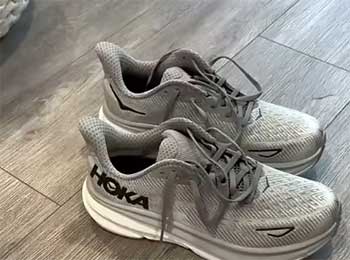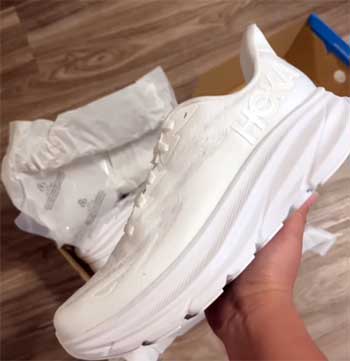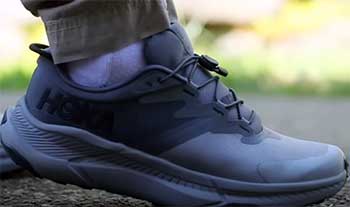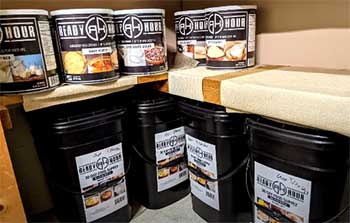I’ve been lacing up running shoes for years, chasing miles on city streets, park trails, and even the occasional treadmill.
When it came time to pick my next pair, I found myself torn between two Hoka heavyweights: the Clifton 9 and the Transport. Both promise comfort and performance, but they cater to different needs.
In this article, I’ll break down my experience with each, comparing their features, pros, and cons to help you decide which shoe fits your lifestyle. Whether you’re a runner or a city walker, let’s find your perfect sole mate.
A Brief Comparison Table
| Feature | Hoka Transport | Hoka Clifton 9 |
| Primary Use | Walking, commuting, light hiking | Running, walking, daily training |
| Weight | 11.2 oz (men’s), 9.1 oz (women’s) | 8.7 oz (men’s), 7.3 oz (women’s) |
| Heel-to-Toe Drop | 5 mm | 5 mm |
| Stack Height | 34.1 mm (heel), 26.1 mm (forefoot) | 32 mm (heel), 27 mm (forefoot) |
| Cushioning | Balanced, slightly firm | Plush, soft |
| Upper Material | Cordura (100% rPET) | Engineered knit |
| Outsole | Vibram EcoStep (90% oil-free) | Durabrasion rubber |
| Fit | True to size, slightly narrow | True to size, medium width, wide option |
| Stability | Neutral, wide base | Neutral, Meta-Rocker |
| Price | $150 | $145 |
| Best For | Urban commuters, casual walkers | Runners, long-distance training |
This table gives you a snapshot, but the real story unfolds in the details. Let’s walk (and run) through my experience with these shoes.
My Journey With Hoka: Why These Shoes?
As a runner who also spends hours walking through city streets, I need shoes that can keep up with my pace—whether I’m logging miles or just navigating a busy day. Hoka’s reputation for cushioning and comfort drew me to the Clifton 9 and Transport.
The Clifton 9 is a legend in the running world, known for its lightweight, plush ride. The Transport, meanwhile, caught my eye as a versatile, lifestyle-focused shoe with a rugged edge.
I tested both over weeks, pounding pavement, strolling parks, and even tackling light trails to see how they stack up.
Hoka Clifton 9: The Runner’s Dream

Let’s start with the Clifton 9, Hoka’s flagship daily trainer.
Slipping into these shoes felt like stepping onto a cloud.
At 8.7 ounces for men’s and 7.3 ounces for women’s, they’re impressively light for their cushioning level.
The compression-molded EVA foam midsole delivers a plush, responsive ride that absorbs impact without feeling mushy.
I took these on a 10-mile run, and my knees thanked me—no jarring, just smooth transitions thanks to Hoka’s Meta-Rocker geometry, which guides your foot from heel to toe like a gentle rocking chair.
The engineered knit upper hugs your foot like a cozy sock, adapting to your shape without pinching. I have slightly wide feet, and the standard fit felt snug but not constricting; there’s also a wide option for broader feet.
The gusseted tongue stays put, preventing annoying slippage during long runs. I noticed the breathability was solid, keeping my feet cool during a humid 5K, though it’s not the airiest for scorching summer days.
Durability is another win. The Durabrasion rubber outsole held up after 50 miles of mixed surfaces—pavement, gravel, and even some dirt paths.
The Clifton 9’s neutral stability suits most runners, but if you overpronate heavily, you might need a shoe with more motion control, like Hoka’s Arahi 7. Priced at $145, it’s a solid value for a shoe that handles daily training, recovery runs, and even casual walks.
Pros of The Clifton 9
- Lightweight for a maximalist shoe, making it ideal for long runs.
- Plush cushioning absorbs impact, perfect for joint protection.
- Meta-Rocker design ensures smooth heel-to-toe transitions.
- Breathable knit upper adapts to various foot shapes.
- Durable outsole withstands high mileage.
- Available in wide sizes for broader feet.
- Versatile for running, walking, or casual wear.
Cons of The Clifton 9
- Not ideal for speedwork; the soft cushioning feels sluggish at faster paces.
- Limited stability for severe overpronators.
- Breathability could be better in extreme heat.
- Slightly narrow standard fit may not suit very wide feet without the wide option.
Hoka Transport: The Urban Adventurer

Now, let’s talk about the Transport.
This shoe is Hoka’s answer to the commuter’s lifestyle, blending running-shoe comfort with a rugged, city-savvy design.
At 11.2 ounces for men’s and 9.1 for women’s, it’s heavier than the Clifton 9, but it feels sturdy, like it’s built to last.
The Cordura upper, made from 100% recycled plastic, is tough as nails.
I scuffed it against concrete curbs, and it barely showed a mark—perfect for urban jungles.
The Vibram EcoStep outsole, with 90% oil-free components, grips like a hiking boot. I tested it on wet sidewalks and light gravel trails, and it never slipped. The midsole, made with 30% sugarcane EVA foam, strikes a balance between soft and firm.
It’s not as plush as the Clifton 9, but it’s protective enough for all-day wear. I walked 20,000 steps in a day at an outdoor market, and my feet stayed happy—no blisters, no soreness.
The quick-toggle lace system is a game-changer for commuters. I could slip these on and off while juggling coffee and a briefcase. Traditional laces are included if you prefer a custom fit, which I switched to for longer walks.
The fit is true to size but leans narrow, especially in the forefoot. My wide feet felt slightly cramped after hours of walking, so those with broader feet might need to size up or try the men’s version for women.
The Transport’s 5 mm heel-to-toe drop and 34.1 mm heel stack height provide a stable, grounded feel. Its wide base adds confidence on uneven surfaces, making it a great pick for city walkers or light hikers.
At $150, it’s slightly pricier than the Clifton 9, but its durability and versatility justify the cost for non-runners.
Pros of The Transport
- Durable Cordura upper withstands urban wear and tear.
- Vibram outsole offers excellent traction on wet or light trails.
- Quick-toggle laces make for easy on-and-off.
- Balanced cushioning supports all-day walking.
- Sustainable materials (sugarcane EVA, recycled upper) appeal to eco-conscious buyers.
- Wide, stable base enhances confidence on varied surfaces.
- Water-resistant upper handles light rain well.
Cons of The Transport
- Heavier than the Clifton 9, less ideal for running.
- Narrow fit may not suit wide feet comfortably.
- Less plush cushioning compared to Clifton 9.
- Limited breathability due to sturdy Cordura upper.
- Not designed for high-performance running.
Head-to-Head Comparison of Hoka Transport And Clifton 9
Let’s put these shoes side by side and see how they perform in real-world scenarios. I tested them across running, walking, and casual use to highlight where each shines.
- Cushioning and Comfort

The Clifton 9’s plush CMEVA midsole is a runner’s dream.
Its softness, measuring 18.2% softer than average in lab tests, absorbs impact like a sponge.
During a half-marathon training run, it kept my legs fresh, even on concrete.
The Transport, with its balanced cushioning (21.9 HA, 23% softer than average walking shoes), feels firmer but still protective.
I wore it for a 10-hour day chasing kids as a nanny, and the moderate softness prevented fatigue without being overly squishy.
Winner: Clifton 9 for runners; Transport for all-day walking.
- Fit and Sizing
Both shoes fit true to size, but the Clifton 9’s engineered knit upper adapts better to different foot shapes. Its medium-width fit felt snug yet flexible, and the wide option is a bonus for broader feet.
The Transport’s Cordura upper is stiffer and narrower, especially in the forefoot (95 mm vs. Clifton’s 97.8 mm). I noticed slight pressure on my toes after long walks, and online reviews echo this for wider feet.
Winner: Clifton 9 for fit versatility.
- Durability and Traction
The Transport’s Cordura upper and Vibram outsole are built like tanks. I dragged them through muddy hikes and city streets, and they held up like hiking shoes. Lab tests show the upper resists scuffs better than many running shoes.
The Clifton 9’s Durabrasion rubber outsole is no slouch, lasting through 50 miles with minimal wear, but its knit upper is less rugged. For traction, the Transport’s grippy Vibram outsole outperforms the Clifton on wet or loose surfaces.
Winner: Transport for durability and traction.
- Style and Versatility
The Clifton 9 looks like a classic running shoe—sleek, sporty, and available in vibrant colors. I wore it casually with jeans, and it blended in well. The Transport, with its earthy tones and minimalist design, feels more lifestyle-oriented.
It pairs better with casual outfits and doesn’t scream “running shoe.” For versatility, the Transport handles commuting, walking, and light hiking, while the Clifton 9 excels at running but doubles as a casual shoe.
Winner: Transport for lifestyle versatility; Clifton 9 for sporty aesthetics.
- Price and Value
At $145, the Clifton 9 offers excellent value for runners logging high mileage. Its lightweight design and durability make it a workhorse. The Transport, at $150, is pricier but justifies the cost with its rugged build and commuter-friendly features.
If you’re a dedicated runner, the Clifton 9 gives more bang for your buck. For urban walkers, the Transport’s durability and traction make it worth the extra $5.
Winner: Tie, depending on your primary use.
My Experience With Hoka Transport And Clifton 9

To give you a clear picture, I put both shoes through their paces.
For the Clifton 9, I ran a mix of 5K, 10K, and long runs up to 13 miles.
The plush cushioning and Meta-Rocker made every step feel effortless, though it lagged during sprints—too soft for speedwork.
I also walked in them for errands, and they felt light and comfortable, though less grippy on wet pavement.
The Transport was my go-to for a weekend trip to a rainy city. I walked 15 miles daily, navigating cobblestone and slick sidewalks. The Vibram outsole kept me steady, and the quick-toggle laces were a lifesaver at airport security.
However, after hours of walking, the narrower fit pinched my toes slightly. I also tried a light jog, but the firmer ride and extra weight confirmed it’s not a running shoe.
- Who Should Choose The Clifton 9?
If you’re a runner—beginner or seasoned—the Clifton 9 is your match. Its lightweight, cushioned ride suits daily training, long runs, or recovery days. It’s also great for walkers who want a sporty, versatile shoe for mixed activities.
If you have neutral arches and value comfort over speed, this shoe will carry you far. Just don’t expect it to keep up with tempo runs or severe overpronation.
- Who Should Choose The Transport?
The Transport is for urban commuters, avid walkers, or anyone needing a durable, all-day shoe. Its rugged build and grippy outsole make it ideal for city streets, light trails, or travel. If you prioritize sustainability, quick on-and-off convenience, and a lifestyle look, this shoe fits the bill.
However, runners or those with wide feet might find it less accommodating.
- Sustainability: A Nod to the Transport
Hoka’s push for eco-friendly materials in the Transport impressed me. The 30% sugarcane EVA midsole and 100% recycled Cordura upper reduce environmental impact without sacrificing performance. T
he Vibram EcoStep outsole, with 90% oil-free components, adds to its green credentials. The Clifton 9, while durable, doesn’t match this level of sustainability, which might sway eco-conscious buyers.
- Breathability and Weather Resistance
The Clifton 9’s knit upper breathes better, keeping my feet cooler during runs. However, it’s not water-resistant, so light rain left my socks damp.
The Transport’s Cordura upper is water-resistant, handling drizzle and puddles well, but it traps heat. In lab tests, the Transport scored a 1/5 for breathability, making it less ideal for hot climates.
Winner: Clifton 9 for breathability; Transport for weather resistance.
- Long-Term Comfort and Support
After weeks of testing, the Clifton 9’s plush cushioning won for long runs. My legs felt fresh after 10 miles, and the Meta-Rocker kept my gait smooth. The Transport’s firmer midsole and wider base shone during long walks, providing stability on uneven surfaces.
However, its narrower fit caused mild discomfort after extended wear, especially for my wider feet.
Winner: Clifton 9 for running comfort; Transport for walking stability.
Frequently Asked Questions (FAQ)
The Hoka Transport is designed for commuting, walking, and light hiking, offering durability, traction, and all-day comfort for urban and lifestyle use.
Yes, if you’re a city walker or commuter needing a durable, grippy shoe with sustainable materials. They’re less ideal for runners or those with wide feet.
The Clifton 9 excels for running, daily training, and long-distance walks, offering lightweight, plush cushioning for neutral runners and casual wear.
The Transport’s narrower fit may not be ideal for bunions. The Clifton 9, with its wider option and flexible knit upper, is a better choice.
Conclusion: Your Perfect Hoka Awaits
You’re standing at a crossroads, deciding between the Hoka Clifton 9 and Transport. If running is your passion, the Clifton 9’s lightweight, plush ride will carry you through miles of training with ease. Its versatility and comfort make it a no-brainer for runners and casual walkers alike.
But if you’re navigating city streets, commuting, or tackling light trails, the Transport’s durability, traction, and eco-friendly design will keep you steady and stylish. Consider your primary needs—running or walking, speed or stability—and choose the shoe that matches your stride.
Your perfect Hoka is waiting to hit the ground running.

